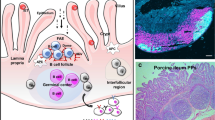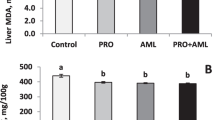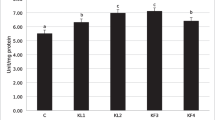Abstract
The comparative effects of potentiated zinc oxide (pZnO) and antibiotic growth promoters (AGP) supplementation on intestinal morphometry and nutrient digestibility in broiler chickens were studied. Four hundred straight-run Cobb 500-day-old broiler chicks were randomly allotted to four dietary treatments replicated 10 times with 10 birds per replicate. Dietary treatments were as follows: T1: basal diets without AGP (negative control; NC), T2: basal diets with 500 g/t maduramicin 10 g and 500 g/t zinc bacitracin 150 (positive control; PC), T3: NC added with 150 g/t pZnO, and T4: PC added with 150 g/t pZnO in a 2 × 2 factorial design in RCBD. At days 18 and 35, 10 birds were randomly selected per treatment for morphometry of the duodenum, jejunum, and ileum. At day 38, eight birds per treatment were used for the nutrient digestibility study. Results showed significant interaction effects (P < 0.05) of AGP and pZnO supplementation on day 35 intestinal morphometry of duodenum’s villi height and villi height: crypt depth, and ileum’s crypt depth; apparent CODGE, AME, CP, DM, and EE. Significant differences (P < 0.05) with pZnO supplementation were only observed on feed intake and FCR of birds fed with pZnO at days 8–14 and fecal quality at days 0–7. Results of present study suggested that pZnO has the potential to replace AGPs without negatively affecting the intestinal morphometry, digestibility, and growth performance of broiler chickens.

Similar content being viewed by others
Data availability
All data generated or analyzed during this study are included in this article.
Code availability
Not Applicable.
References
Ali M, A. Jamal, H. Saeed, M.Z. Abiden, M.H. Nawaz, and A. Irfan.2019. Impact of zinc supplementation on growth performance, carcass traits and immune response in broilers fed antibiotic free diet. Int J Biotechnol Recent Adv. 2019; 2(1): 60–63. doi: https://doi.org/10.18689/ijbr-1000110.
AOAC. 2019. Official methods of analysis. 21st ed. USA: AOAC International.
Awad, W. A., C. Hess, and M. Hess. 2017. Enteric pathogens and their toxin-induced disruption of the intestinal barrier through alteration of tight junctions in chickens. Toxins 9(2):60. doi ARTN 6010.3390/toxins9020060.
Buff C. E., D. W. Bollinger, M.R. Ellersieck, W.A. Brommelsiek, and T.L. Veum. 2005. Comparison of growth performance and zinc absorption, retention, and excretion in weanling pigs fed diets supplemented with zinc-polysaccharide or zinc oxide. J. Anim. Sci. 83:2380–2386. doi:https://doi.org/10.2527/2005.83102380x.
Cavaco, L.M., H. Hasman, and F.M. Aarestrup. 2011. Zinc resistance of Staphylococcus aureus of animal origin is strongly associated with methicillin resistance. Veterinary Microbiology 150 (3-4), pp.344. https://doi.org/10.1016/j.vetmic.2011.02.014 . hal-00696635
Garcia, B.A., A.T.A. Aguirre-Reyes, K.S. Decena and R.C. Sulabo. 2019. Effect of performance enhancer mixture as replacement for antibiotic growth promoters on production performance, excreta quality and carcass characteristics of broilers. Philipp J Vet Anim Sci 2019 45(1):34–47
Garcia, V., P. Catala-Gregori, F. Hernandez, M.D. Megias, and J. Madrid. 2007. Effect of formic acid and plant extracts on growth, nutrient digestibility, intestine mucosa morphology, and meat yield of broilers. The Journal of Applied Poultry Research, 16(4), 555–562.doi:https://doi.org/10.3382/japr.2006-00116
Garg, A.K., V. Mudgal, and R.S. Dass. 2008. Effect of organic zinc supplementation on growth, nutrient utilization and mineral profile in lambs. Anim. Feed Sci. Technol. 144, 82–96.
Ghosh, T. K., S. Haldar, M.R. Bedford, N. Muthusami, and I. Samanta. 2011. Assessment of yeast cell wall as replacements for antibiotic growth promoters in broiler diets: effects on performance, intestinal histo-morphology and humoral immune responses. Journal of Animal Physiology and Animal Nutrition, 96(2), 275–284.doi:https://doi.org/10.1111/j.1439-0396.2011.01155.x
Heak, C., P. Sukon, S. Kongpechr, B. Tengjaroenkul and K. Chuachan. 2017. Effect of Direct-fed Microbials on Intestinal Villus Height in Broiler Chickens: A Systematic Review and Meta-Analysis of Controlled Trials. Int. J. Poult. Sci., 16: 403-414.
Hedayati M., and M Manafi. 2018. Evaluation of Anherbal Compound, a Commercial Probiotic, and an Antibiotic Growth Promoter on the Performance, Intestinal Bacterial Population, Antibody Titers, and Morphology of the Jejunum and Ileum of broilers. Brazilian Journal of Poultry Science , 20(2), 305–316. doi:https://doi.org/10.1590/1806-9061-2017-0639
Hill, G.M., D.C. Mahan, S.D. Carter, G.L.Cromwell, R.C.Ewan, R.L. Harrold, A.J Lewis, P.S. Miller, G.C. Shurson, and T.L. Veum. 2001. Effect of pharmacological concentrations of zinc oxide with or without the inclusion of an antibacterial agent on nursery pig performance. J Anim Sci. 2001 Apr;79(4):934–41. doi: https://doi.org/10.2527/2001.794934x
Jahanian, R., H. Moghaddam, Nassiri, and A. Rezaei.. 2008. Improved broiler chick performance by dietary supplementation of organic zinc sources. Asian-Australas. J. Anim. Sci, 21, 1348-1354. doi: https://doi.org/10.5713/ajas.2008.70699
Kidd, M. T., N. B. Anthony, and S. R. Lee. 1992. Progeny performance when dams and chicks are fed supplemental zinc. Poult. Sci. 71:1201–1206.
Kidd, M. T., M. A. Qureshi, P. R. Ferket, and L. M. Thomas. 1994. Blood clearance of Eschericheria coli and evaluation of mononuclear-phagocytic system as influenced by supplemental dietary zinc methionine in young turkeys. Poult. Sci. 73:1318–1389.
Kromm, V. and A. Romeo. 2017. Antibacterial effects of zinc oxide in weaned piglets. International Pig Topics 32 (1); 11-14.
Kumar N.A., V. Kapoor, and V.K. Paliwal.2002. Effect of zinc supplementation in conventional diets on nutrient digestibility, growth and nitrogen balance in kids. Annals of Biological Research 7, 201–206.
Li, B. T., A.G. Van Kessel, W. R. Caine, S.X. Huang, and R. N. Kirkwood. 2001. Small intestinal morphology and bacterial populations in ileal digesta and feces of newly weaned pigs receiving high dietary levels of zinc oxide. Canadian Journal of Animal Science 81: 511-516.
Lu, P., J. Choi, C. Yang, M. Mogire, S. Liu, L. Lahaye, D. Adewole, A. Rodas-Gonzalez, and C. Yang. 2020. Effects of antibiotic growth promoter and dietary protease on growth performance, apparent ileal digestibility, intestinal morphology, meat quality, and intestinal gene expression in broiler chickens: a comparison. Journal of Animal Science, 98(9), skaa254. https://doi.org/10.1093/jas/skaa254
Mandal GP, R.S. Dass, D.P. Isore, A.K. Garg, and G.C. Ram. 2007. Effect of zinc supplementation from two sources on growth, nutrient utilization and immune response in male crossbred cattle (Bos indicus · Bos taurus) bulls. Animal Feed Science and Technology 138, 1–12. doi:https://doi.org/10.1016/j.anifeedsci.2006.09.014
Miller, E. R., R. W. Leucke, D. E. Ullrey, B. U. Baltzer, B. L. Bradley, and J. A. Holfer. 1968. Biochemical, skeletal and allometric changes due to zinc deficiency in the baby pig. J. Nutr. 95:278–286.
Miyoshi, Y., S. Tanabe., and T. Suzuki. 2016. Cellular zinc is required for intestinal epithelial barrier maintenance via the regulation of claudin-3 and occludin expression. Am J Physiol Gastrointest Liver Physiol 311: G105–G116, 2016. doi: https://doi.org/10.1152/ajpgi.00405.2015.
Modi, C.M., S.K. Mody, H.B. Patel, G.B. Dudhatra, A. Kumar and T.J. Sheikh. 2011. Growth promoting use of antimicrobial agents in animals. Journal of Applied Pharmaceutical Science 01 (08); 2011: 33–36
Montagne, L., J. Pluske, J. and D. Hampson. 2013. A review of interactions between dietary fibre and the intestinal mucosa, and their consequences on digestive health in young non-ruminant animals. Animal Feed Science and Technology, 108(1–4), 95–117. doi:https://doi.org/10.1016/s0377-8401(03)00163-9
Morales, J., G. Cordero, C Piñeiro, and S. Durosoy. 2012. Zinc oxide at low supplementation improves productive performance and health status of piglets. J. Anim. Sci. 90: 436-438. doi: https://doi.org/10.2527/jas53833
Mountzouris, K. C., P. Tsitrsikos, I. Palamidi, A. Arvaniti, M. Mohnl, G. Schatzmayr, and K. Fegeros. 2009. Effects of probiotic inclusion levels in broiler nutrition on growth performance, nutrient digestibility, plasma immunoglobulins, and cecal microflora composition. Poultry Science, 89(1), 58–67.doi:https://doi.org/10.3382/ps.2009-00308
Murugesan G.R., B. Syed, S. Haldar and C. Pender . 2015. Phytogenic feed additives as an alternative to antibiotic growth promoters in broiler chickens. Front. Vet. Sci. 2:21. doi: https://doi.org/10.3389/fvets.2015.00021
Ndelekwute, E.K, K.D Afolabi, H.O. Uzegbu, and E.B. Essien. 2015. Effect of dietary formic acid as replacement of streptomycin on growth and nutrient digestibility in broiler. Bang. J. Anim. Sci. 2015. 44(1(: 69–74
Oh,H.-J., Y.-J. Park, J.H Cho, M.-H. Song, B.-H. Gu, W. Yun, J.-H. Lee, J.-S. An, Y.-J Kim. J.-S. Lee. S. Kim, H. Kim, E.-S. Kim, B.-K. Lee, B.-W. Kim, H.-B. Kim, J.-H. Cho, and M.-H. Kim. 2021. Changes in diarrhea score, nutrient digestibility, zinc utilization, intestinal immune profiles, and fecal microbiome in weaned piglets by different forms of zinc. Animals 2021, 11, 1356. https://doi.org/10.3390/ani11051356
Pimentel, J. L., M. E. Cook, and J. L. Greger. 1991. Immune response of chicks fed various levels of zinc. Poult. Sci. 70:947–954.
Ramiah, S.K., E. A. Awad, S. Mookiah, and Z. Idrus. 2019. Effects of zinc oxide nanoparticles on growth performance and concentrations of malondialdehyde, zinc in tissues, and corticosterone in broiler chickens under heat stress conditions. Poultry Science 98:3828–3838. http://dx.doi.org/https://doi.org/10.3382/ps/pez093
Raquipo, J.M.B.R., F.C.C. Reyes, B. A. Moog, E. P. Angeles, A.F.S. Regaspi, and A. M. Cuizon. 2017. Performance of nursery pigs fed diets with coated or potentiated zinc oxide. Philipp J Vet Anim Sci 2017 43 (2): 133–138
Romeo, A. 2014. Understanding the zinc pathways in animals. All About Feed 22 (7):16-17
Salama, A.A., G. Caja, E. Albanell, X. Such, R. Casals, and J. Plaixats. 2003. Effects of dietary supplements of zinc-methionine on milk production, udder health and zinc metabolism in dairy goats. J Dairy Res. 70(1):9-17. doi: https://doi.org/10.1017/s0022029902005708.
Santin, E., A. Maiorka, M. Macari, M. Grecco, J.C. Sanchez, T.M. Okada, and A.M. Myasaka. 2001. Performance and intestinal mucosa development of broiler chickens fed diets containing Saccharomyces cerevisae cell wall. Journal of Applied Poultry Research 10, 236–244.
Sharifi, S. D., A. Dibamehr, H. Lotfollahian, and B. Baurhoo. 2012. Effects of flavomycin and probiotic supplementation to diets containing different sources of fat on growth performance, intestinal morphology, apparent metabolizable energy, and fat digestibility in broiler chickens. Poultry Science, 91(4), 918–927.doi:https://doi.org/10.3382/ps.2011-01844
Swinkels, J. W., E. T. Kornegay, and M. W. Verstegen. 1994. Biology of zinc and biological value of dietary organic zinc complexes and chelates. Nutr. Res. Rev. 7:129–149.
Tomaszewska, E, S. Muszyński, P. Dobrowolski, M. Kwiecień, A. Winiarska-Mieczan, I. Świetlicka, and A. Wawrzyniak. 2017. Effect of zinc level and source (Zinc oxide vs. Zinc glycine) on bone mechanical and geometric parameters, and histomorphology in male Ross 308 broiler chicken. Brazilian Journal of Poultry Science 19(1), 159–170. https://doi.org/10.1590/1806-9061-2016-0285
Vela, G., P Stark, M. Socha, A.K. Sauer, S. Hagmeyer, and A.M. Grabrucker. 2015. Zinc in gut-brain interaction in autism and neurological disorders. Neural plasticity, 972791. https://doi.org/https://doi.org/10.1155/2015/972791
Wang, X., M.C. Valenzano, J.M. Mercado, E.P. Zurbach and J.M Mullin. 2013. Zinc supplementation modifies tight junctions and alters barrier function of CACO-2 human intestinal epithelial layers. Dig Dis Sci 58:77–87. doi https://doi.org/10.1007/s10620-012-2328-8.
Weng X, A.P.A Monteiro, J. Guo, C. Li, R.M. Orellana, T.N. Marins, J.K. Bernard, D.J. Tomlinson, J.M. DeFrain, S.E. Wohlgemuth, and S. Tao. 2018. Effects of heat stress and dietary zinc source on performance and mammary epithelial integrity of lactating dairy cows. J Dairy Sci. 101(3):2617-2630. doi: https://doi.org/10.3168/jds.2017-13484.
Zhang B, and Y. Guo. 2009. Supplemental zinc reduced intestinal permeability by enhancing occludin and zonula occludens protein-1 (ZO-1) expression in weaning piglets. Br J Nutr. 2009;102: 687–693. doi:https://doi.org/10.1017/S0007114509289033.
Funding
This research work was supported by PhilNutri Corporation and Animine.
Author information
Authors and Affiliations
Contributions
BM and AA conceived and designed the research and conducted the experiment. All authors are involved in the analysis of the results of the experiment and write-up of the manuscript.
Corresponding author
Ethics declarations
Informed consent
Informed consent was obtained from all individual participants included in the study.
Research involving human participants and/or animals
All applicable international, national, and/or institutional guidelines for the care and use of animals were followed.
Conflict of interest
The authors declare no competing interests.
Additional information
Publisher's note
Springer Nature remains neutral with regard to jurisdictional claims in published maps and institutional affiliations.
Rights and permissions
About this article
Cite this article
Moog, B.A., Angeles, A.A., Merca, F.E. et al. Comparative effect of potentiated zinc oxide and antibiotic growth promoters on intestinal morphometry and nutrient digestibility in broiler chickens. Trop Anim Health Prod 54, 16 (2022). https://doi.org/10.1007/s11250-021-03012-7
Received:
Accepted:
Published:
DOI: https://doi.org/10.1007/s11250-021-03012-7




